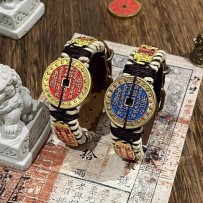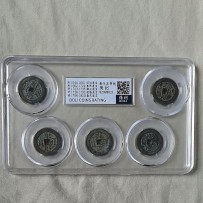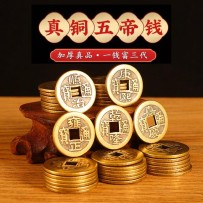The talisman money is a Taoist prayer object. These coins are cast with patterns of the Eight Diagrams, immortals, Taishang Laojun, and the God of Thunder. The mountain ghost flower money is a carrier used by Taoist priests in the Qing Dynasty to cast spells to subdue demons and exorcise ghosts. It can also be called a magic tool. After being consecrated by Taoist priests, people are requested to hang it in their homes or carry it with them to ensure safety.
Ancient Coin
The Five Emperors' Coins refer to five round copper coins with square holes, which symbolize the power of the five elements and the five directions, and have the function of warding off evil spirits and bringing good fortune. The saying that the five emperors minted coins is mostly fabricated by later generations. People call the coins issued by several dynasties the Great Five Emperors' Coins. The Great Five Emperors' Coins are made of bronze, including the Qin Banliang, the Han Wuzhu, the Tang Kaiyuan Tongbao, the Song Yuan Tongbao, and the Ming Yongle Tongbao.
The early forms of ancient coins were mainly shellfish. In China, from the late primitive society to the Xia, Shang and Zhou dynasties, the main form of currency was physical currency, and the most widely circulated was natural shellfish. Later, a small amount of metal weighing currency and coins appeared.
The Ten Emperors' Coins are copper coins with the reign titles of the ten emperors: Shunzhi, Kangxi, Yongzheng, Qianlong, Jiaqing, Daoguang, Xianfeng, Tongzhi, Guangxu and Xuantong. They are now commonly known as the Ten Emperors' Coins.
The Five Emperors' Coins refer to copper coins with round holes and square holes. Ancient copper coins were cast according to the principle of "round outside and square inside" and "harmony between man and nature". They are the embodiment of the ancient Yin-Yang and Five Elements theory and have a profound cultural attribute.












